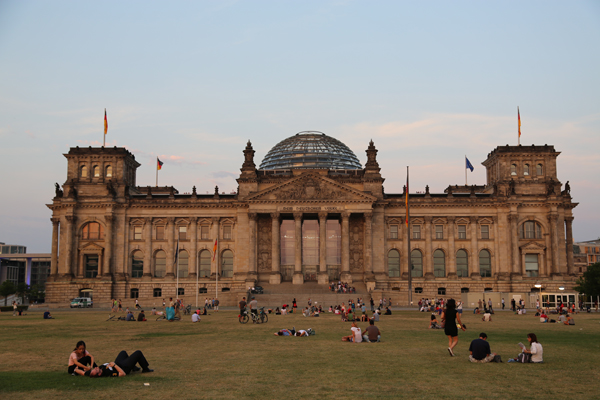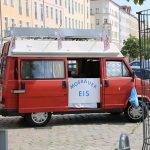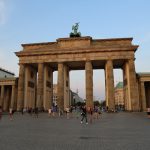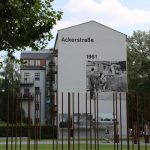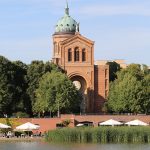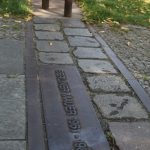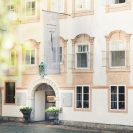“They say the Berlin Wall no longer exists on the streets but in the mind. When it was extant, the Wall didn’t meander through the city, it bogarted. Its inexorable ghost is just as belligerent. It cuts uninvited through vacant lots and pricey new condominiums, rattling its hammer and sickle, spooking the tourists and locals who travel along this invisible barrier” – Paul Beatty, Slumberland.
In Paul Beatty’s Berlin-based satirical novel, the characters DJ Darky and “Schwa” an eccentric jazz musician, decide to rebuild the wall, not with concrete, but through music.
In 2006, Berlin’s city planners completed the Berlin Wall Trail or Berliner Mauerweg as it is known in German, a cycle and hiking trail, which traces the 160 km course of the former East German border fortifications that encircled West Berlin from 1961 to 1989.
Last year in November 2014 white, helium balloons -perched on 3.6m poles and spanning a 15 km stretch of the former death strip – were released one by one to symbolize the 25th anniversary of the fall of the wall.
The physical wall may be gone but its ghost still hangs around the city and cycling it is one of the best ways to commune with it.
The line of this historical barrier is now clearly sign-posted and marked with a double row of grey cobble stones and in some sections a commemorative metal plaque marks the time period that the wall stood.
Berlin is one of Europe’s bike friendliest cities. It is fairly flat with an extensive network of marked bicycle paths. To cycle the full length of the Wall Trail would take two days if you were bike fit, or three days if you wanted to enjoy the scenery. We did not have the time to follow the whole trail so we followed roughly the route of last year’s commemorative art installation that took us through the heart of the city.
We started our ride at Bernauerstrasse. This section is heavily dotted with memorial walks, preserved sections of wall, documentation centers, and museums.
The former patrol road that runs along Benauerstrasses from Schwedterstrasse to Brunnenstrasse is now a memorial trail commemorating the daring and sometimes fatal escapes from East to West Berlin captured by the media. A permanent photo exhibit of these vivid images runs between the old buildings and the new condominiums that have sprung up on what was the former “death strip.” The dramatic stories told at the info stops are in sharp contrast with the leafy pleasantness of this now gentrified part of the former East.
Preserved sections of the wall are found between Brunnenstasse and the Nordbahnhof. On the sunny day we did our cycle, locals and tourists picnicked on the now green areas where the death strip ran. Tourists meandered through gaps between spikes that stand like a phantom wall – something that would have been impossible just over 25 years ago. Locals cycled past on the bike path, seemingly blasé of the historical landmarks. Small plaques embedded into the footpath are gruesome reminders of the some of the 138 persons who lost their lives trying to escape across the border strip.
The Documentation Center on Benauerstrasse has a free viewing platform that gives you a stunning birds eye view of the small section of wall preserved in its original form.
Here the route takes you past two former ghost stations. The trains that passed beneath former East Berlin did not stop at Benauerstrasse subway station until its reopening after the fall of the wall. What remained of the overground station of Nordbahnhof was also boarded up. Nowadays a fully functioning S-Bahn station, the Nordbahnhof hosts an exhibition of its former life as a geisterbahnhof or ghost station. The station still retains the old gothic script of the pre-Nazi era giving it an air of belonging to another time.
Just a few blocks from the Nordbahnhof is one of Berlin’s oldest cemeteries, the Invalidenfriedhof, the traditional resting place of the Prussian army. It was located just behind the wall in East Berlin, sections of which still remain. In the 1960s over a third of the cemetery was destroyed to make way for watch towers and patrol roads.
The route from the Nordbahnhof to the notorious, former border crossing of Check Point Charlie is lined with monuments to tick off the tourist to do list: the Reichstag, Brandenburg Gate, and the beautiful Martin Gropius Bau museum and the eerie holocaust memorial with its labyrinth of more than 2,700 grey concrete slabs reminiscent of coffins.
There are parts of the trail where the ghosts are harder to find. In Postdamer Platz commercialism has erased all signs of the wall. After its devastation in the war and its isolation by the wall, the square once stood as a vacant lot. But now it is a modern business district that could be anywhere in the world with its malls and shiny office buildings.
Sight seeing opportunities in some sections of the trail are scarce, as it takes you through areas tourists would seldom venture. In parts of residential Kreuzberg, the cobblestone wall markings running alongside the residential buildings look like they have been laid down to delineate parking lanes. Vacant grassy lots – a quiet testament to the devastation Berlin suffered in the war – still remain, but nearby building construction is a reminder that the empty spaces are slowly being filled in with luxury housing, Since the fall of the wall this immigrant suburb -and center of the West Berlin squatter movement in the 1980s – has become one of the most sought after areas of the new Berlin.
But ghosts will still surprise you on the way. The Kreuzberg section of the trail takes you close to the beautiful St. Michael’s church that had been badly damaged during the war and its fountain and garden isolated in the death strip. Since unification its fountain and gardens have been resurrected to their former glory and although parts of the church have been restored, its center was never re-built.
The last section we rode took us over the striking Oberbaum Bruke, the bridge over the River Spree that links the former East German suburb of Friedrischhain with Kreuzberg.
Just past the bridge stands the East side Gallery, a conserved mural project by international artists who came together in 1990 to celebrate the fall of the wall. It is the longest remaining section still standing at 1.3 kilometers. Some of the most iconic murals in the gallery depict the ghosts of that time – the East German Trabant car that appears to be breaking through the concrete and the former East German leader Erich Honecker locked in a kiss with the former Soviet leader President Leonid Brezhnev. For the 20th anniversary of the Wall’s demise in 2009, this section was completely restored but many murals are now defaced by tourist tags and some are difficult to view behind the numerous tourists holding selfie sticks.
Will the East side gallery itself one day become a ghost of its former self? In March 2013 a number of panels were removed to gain a high-rise residential development along the River Spree. Large protests by residents prevented further destruction of the gallery.
For now at least, the ghosts of the wall are allowed to roam Berlin.
For more information visit wall.visitberlin.de or https://berlinonbike.de/en/. Berlin Mauerweg maps are available at book and bicycle shops if you want to go it alone and bike rentals are located all over Berlin starting from 12 Euros per day. Photography by Christopher Johns.

